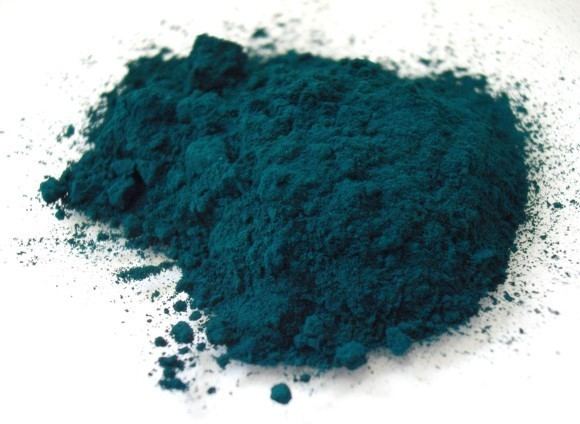Hex triplet #123524 CMYK (c, m, y, k) (82, 51, 80, 64) | sRGB (r, g, b) (18, 53, 36) HSV (h, s, v) (151°, 66%, 21%) | |
 | ||
Source The Mother of All HTML Colo(u)r Charts | ||
Phthalocyanine green G, also called phthalo green, viridian hue, pigment green 7, copper phthalocyanine green, C.I. pigment green 7, non-flocculating green G, polychloro copper phthalocyanine, and C.I. 74260, is a synthetic green pigment from the group of phthalocyanine dyes, a complex of copper(II) with chlorinated phthalocyanine. It is a very soft green powder, insoluble in water.
Contents
Its CAS numbers are 1328-45-6 and 1328-53-6 depending on the extent of chlorine substitition: chemical formula ranges from C32H3Cl13CuN8 to C32HCl15CuN8. It is a bright, high intensity colour used in oil and acrylic based artist's paints, and in other applications.
Properties, chemistry and production
Phthalocyanine green is a phthalocyanine blue pigment where most of the hydrogen atoms are replaced with chlorine. The strongly electronegative chlorine atoms influence the distribution of the electrons in the phthalocyanine structure, shifting its absorption spectrum. It is made by chlorination of the phthalocyanine blue as a melt of sodium chloride and aluminium chloride, to which chlorine is introduced at elevated temperature.
The phthalo green molecules are highly stable. They are resistant to alkali, acids, solvents, heat, and ultraviolet radiation.
Uses
Due to its stability, phthalo green is used in inks, coatings, and many plastics. In application it is transparent. The pigment is insoluble and has no tendency to migrate in the material. It is a standard pigment used in printing ink and packaging industry. It is also allowed in all cosmetics except those used around the eyes, and is used in some tattoos.
Related compounds
Copper phthalocyanine green 36 is a variant where some of the chlorine atoms are replaced with bromine.
Toxicity and hazards
There is evidence that exposure to phalocyanines can cause serious birth defects in developing embryos.
